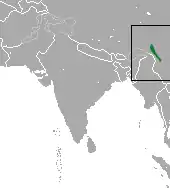Snub-nosed monkey
Snub-nosed monkeys are a group of Old World monkeys and make up the entirety of the genus Rhinopithecus. The genus is rare and not fully researched. Some taxonomists group snub-nosed monkeys together with the genus Pygathrix.
| Snub-nosed monkeys | |
|---|---|
.jpg.webp) | |
| Golden snub-nosed monkey (Rhinopithecus roxellana) | |
| Scientific classification | |
| Domain: | Eukaryota |
| Kingdom: | Animalia |
| Phylum: | Chordata |
| Class: | Mammalia |
| Order: | Primates |
| Suborder: | Haplorhini |
| Infraorder: | Simiiformes |
| Family: | Cercopithecidae |
| Tribe: | Presbytini |
| Genus: | Rhinopithecus Milne-Edwards, 1872 |
| Type species | |
| Semnopithecus roxellana Milne-Edwards, 1872 | |
| Species | |
|
See text | |
Distribution and habitat
Snub-nosed monkeys live in Asia, with a range covering southern China (especially Tibet, Sichuan, Yunnan, and Guizhou) extending into the northern parts of Myanmar and Vietnam. Snub-nosed monkeys inhabit mountain forests up to elevations of more than 4,000 m (13,000 ft). In the winter, they move into the deeply secluded regions. Higher elevation areas are more remote and difficult for humans to access and utilize and other studies have found less deforestation, more reforestation and afforestation, less range contraction, and less extinction in topographically steep areas. All Rhinopithecus species inhabit primary forest and grid cells with tree cover ≥ 75% might constitute important potential habitat.[1]
Description
These monkeys are named for the short stump of a nose on their round faces, with nostrils arranged forward. They have relatively multicolored and long fur, particularly at the shoulders and backs. They grow to a length of 51–83 cm (20–33 in) with a tail of 55–97 cm (22–38 in).
Behavior
Snub-nosed monkeys spend the majority of their life in the trees. They live together in very large groups of up to 600 members, splitting up into smaller groups in times of food-scarcity, such as in the winter. Groups consist of many more males than females. They have territorial instincts, defending their territory mostly with shouts. They have a large vocal repertoire, calling sometimes solo while at other times together in choir-like fashion.
Diet
The diet of these animals consists mainly of tree needles, bamboo buds, fruits and leaves. A multi-chambered stomach helps them with digesting their food.
Breeding
The impulse for mating starts with the female. She takes up eye contact with the male and runs away a short bit, then flashes her genitals. If the male shows interest (which does not always occur), he joins the female and they mate. The 200-day gestation period ends with a single birth in late spring or early summer. Young animals become fully mature in about six to seven years. Zoologists know little about their lifespan.
Conservation
The golden[2] and black-and-white snub-nosed monkeys[3] are both endangered species, while the other three species are critically endangered.[4][5][6]
Golden snub-nosed monkey communities with large populations have high genetic diversity, but also show higher levels of recent inbreeding than other snub-nosed monkeys.[7]
Species
| Common name | Scientific name and subspecies | Range | Size and ecology | IUCN status and estimated population |
|---|---|---|---|---|
| Black-and-white snub-nosed monkey
|
R. bieti (A. Milne-Edwards, 1897) |
Southern China |
Size: 74–83 cm (29–33 in) long, plus 51–72 cm (20–28 in) tail[8] Habitat: Forest[3] Diet: Leaves, fruit, and lichen[8] |
EN
|
| Golden snub-nosed monkey
|
R. roxellana A. Milne-Edwards, 1870 Three subspecies
|
Central China |
Size: 57–76 cm (22–30 in) long, plus 51–72 cm (20–28 in) tail[9] Habitat: Forest[2] Diet: Leaves, bark, and lichen, as well as buds and fruit seeds[9] |
EN
|
| Gray snub-nosed monkey
|
R. brelichi Thomas, 1903 |
Central China |
Size: About 64–73 cm (25–29 in) long, plus 70–97 cm (28–38 in) tail[10] Habitat: Forest[4] Diet: Leaves, buds, fruit, seeds and bark, as well as insect larvae[10] |
CR
|
| Myanmar snub-nosed monkey
|
R. strykeri Geissmann et al., 2010 |
Northern Myanmar |
Size: About 56 cm (22 in) long, plus 78 cm (31 in) tail[11] Habitat: Forest[6] Diet: Leaves, fruit, seeds, buds, flowers, twigs, and bark[12] |
CR
|
| Tonkin snub-nosed monkey
|
R. avunculus (Dollman, 1912) |
Northern Vietnam |
Size: 51–65 cm (20–26 in) long, plus 66–92 cm (26–36 in) tail[13] Habitat: Forest[5] Diet: Leaves, fruit, flowers, and seeds[13] |
CR
|
See also
References
- Nüchel, Jonas; Bøcher, Peder Klith; Xiao, Wen; et al. (2018-01-23). "Snub-nosed monkeys (Rhinopithecus): potential distribution and its implication for conservation". Biodiversity and Conservation. 27 (6): 1517–1538. doi:10.1007/s10531-018-1507-0. ISSN 0960-3115. PMC 6560942. PMID 31258260.
- Yongcheng, L.; Richardson, M. (2021) [amended version of 2020 assessment]. "Rhinopithecus roxellana". IUCN Red List of Threatened Species. 2021: e.T19596A196491153. doi:10.2305/IUCN.UK.2021-1.RLTS.T19596A196491153.en.
- Long, Y.; Bleisch, W. V.; Richardson, M. (2020). "Rhinopithecus bieti". IUCN Red List of Threatened Species. 2020: e.T19597A17943738. doi:10.2305/IUCN.UK.2020-2.RLTS.T19597A17943738.en.
- Long, Y.; Li, B.; Zhou, J.; Ren, B.; Garber, A. (2022). "Rhinopithecus brelichi". IUCN Red List of Threatened Species. 2022: e.T19595A215621115. doi:10.2305/IUCN.UK.2022-1.RLTS.T19595A215621115.en.
- Quyet, L. K.; Rawson, B. M.; Duc, H.; Nadler, T.; Covert, H.; Ang, A. (2020). "Rhinopithecus avunculus". IUCN Red List of Threatened Species. 2020: e.T19594A17944213. doi:10.2305/IUCN.UK.2020-2.RLTS.T19594A17944213.en.
- Geissmann, T.; Momberg, F.; Whitten, T. (2020). "Rhinopithecus strykeri". IUCN Red List of Threatened Species. 2020: e.T13508501A17943490. doi:10.2305/IUCN.UK.2020-2.RLTS.T13508501A17943490.en.
- Kuang, W.; Hu, J.; et al. (December 2020). "Genetic diversity, inbreeding level, and genetic load in endangered snub-nosed monkeys (Rhinopithecus)". Frontiers in Genetics. 11: 615926. doi:10.3389/fgene.2020.615926.
- Deng, Xin (2020). "Rhinopithecus bieti". Animal Diversity Web. University of Michigan. Archived from the original on August 12, 2023. Retrieved July 24, 2023.
- Munoz, Peter (2023). "Rhinopithecus roxellana". Animal Diversity Web. University of Michigan. Archived from the original on August 12, 2023. Retrieved July 24, 2023.
- "Grey snub-nosed monkey (Rhinopithecus brelichi)". ARKive. Wildscreen. Archived from the original on September 9, 2015. Retrieved December 16, 2013.
- Geissmann, T.; Lwin, N.; Aung, S. S.; Aung, T. N.; Aung, Z. M.; Hla, T. H.; Grindley, M.; Momberg, F. (2011). "A new species of snub-nosed monkey, genus Rhinopithecus Milne-Edwards, 1872 (Primates, Colobinae), from northern Kachin state, northeastern Myanmar". American Journal of Primatology. 73 (1): 96–107. doi:10.1002/ajp.20894. PMID 20981682. S2CID 467234. Archived from the original on June 8, 2023. Retrieved August 24, 2023.
- Yang, Y.; Groves, C.; Garber, P.; Wang, X.; Li, H.; Long, Y.; Li, G.; Tian, Y.; Dong, S. (2019). "First insights into the feeding habits of the Critically Endangered black snub-nosed monkey, Rhinopithecus strykeri (Colobinae, Primates)". Primates. 60 (2): 143–153. doi:10.1007/s10329-019-00717-0. PMID 30847671. S2CID 71145324.
- Cherka, Rachel (2014). "Rhinopithecus avunculus". Animal Diversity Web. University of Michigan. Archived from the original on August 12, 2023. Retrieved July 24, 2023.
External links
- Snub-nosed monkey media from ARKive
- Snub-nosed monkey media from ARKive
- Primate Info Net Rhinopithecus Factsheets
.jpg.webp)



.jpg.webp)



